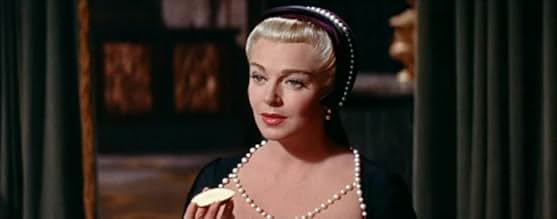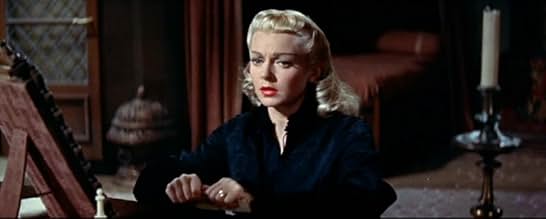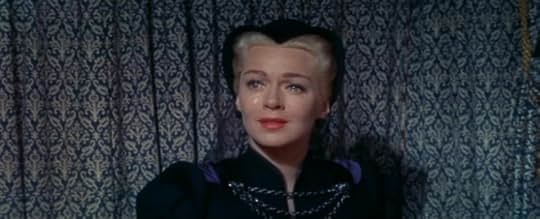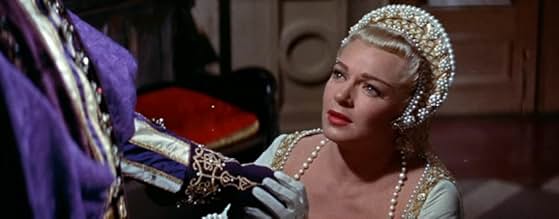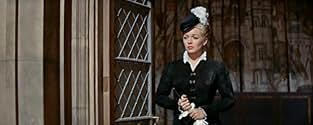Ajouter une intrigue dans votre langueIn the sixteenth century, a noblewoman has a love affair with the French King.In the sixteenth century, a noblewoman has a love affair with the French King.In the sixteenth century, a noblewoman has a love affair with the French King.
- Réalisation
- Scénario
- Casting principal
Avis à la une
If you take this for what it was, Hollywood's take on a real historical event, Diane was an enjoyable movie, as long as you haven't a clue as to what went on then.
They had so much wrong in this story it was rediculious. I mean they even omited Nostradamus, Catherine's protogee, and the one who made the predictions of the kings death and that each of her sons would rule.....for a time. What I would like to know is why they had some squirrely kid predict this? Instead of the truth.
They had so much wrong in this story it was rediculious. I mean they even omited Nostradamus, Catherine's protogee, and the one who made the predictions of the kings death and that each of her sons would rule.....for a time. What I would like to know is why they had some squirrely kid predict this? Instead of the truth.
Lana Turner was a busy actress in the mid-Fifties, appearing in "The Sea Chase" at Warner Brothers, with John Wayne; in Twentieth-Century Fox's lavish remake of "The Rains Came," newly titled "The Rains of Ranchipur," co-starring with Richard Burton; and in her second-to-last at Metro, her long-time home studio, "The Prodigal," one of M-G-M's most expensive made-in-Hollywood spectacles. All were handsomely mounted in CinemaScope and color and all were at least moderately entertaining as well as flattering to the blonde beauty of their leading lady, "Luscious Lana." By the time "Diane" was being lensed on the Culver City soundstages in 1955, M-G-M was in straitened financial circumstances, though one would never know it by observing the deluxe production values liberally applied in the making of this costumer. One month after this picture's release in early 1956, Lana ended her eighteen year association with M-G-M and, for her, it was back to Twentieth for 1957's "Peyton Place" (and a Best Actress Oscar nomination) and thence to Universal-International where, in 1959, Lana and producer Ross Hunter began a run of some extraordinary good luck at the box office, beginning with the ultra-glossy updated remake of "Imitation of Life."
"Diane" provided Lana with a regal departure from M-G-M. All of the elements were liberally provided by M-G-M to support Lana's abilities and beauty. The property was originally planned as a Greta Garbo vehicle some years before; the eventual script was penned by Christopher Isherwood, from a story, departing from historical exactitude, as has always been Hollywood custom, by John Erskine; and visual elements were assigned to the studio's best, including costume designer Water Plunkett, who dressed Lana in a profusion of elaborate black gowns, since Diane is frequently in mourning for one noble or another as the story proceeds to the fadeout. Miklos Rozsa's score is one of his better efforts, sounding a bit less derivative of some of his earlier efforts at musically framing stories with historical settings. Additionally Lana's costars all turn in very professional work, with Marisa Pavan (the sister of the ill-fated actress Pier Angeli) especially effective as Diane's nemesis, Catherine de Medici. As an example of M-G-M's luxurious style of filmmaking, even while the studio teetered on the edge of bankruptcy, this is the kind of entertainment that is rarely reproduced in these sensation-seeking times.
The VHS version is no doubt "formatted" so, unless you are content to wait for a scheduling of this one on Turner Classic Movies, where it most likely would be letterboxed, "Caveat emptor!"
"Diane" provided Lana with a regal departure from M-G-M. All of the elements were liberally provided by M-G-M to support Lana's abilities and beauty. The property was originally planned as a Greta Garbo vehicle some years before; the eventual script was penned by Christopher Isherwood, from a story, departing from historical exactitude, as has always been Hollywood custom, by John Erskine; and visual elements were assigned to the studio's best, including costume designer Water Plunkett, who dressed Lana in a profusion of elaborate black gowns, since Diane is frequently in mourning for one noble or another as the story proceeds to the fadeout. Miklos Rozsa's score is one of his better efforts, sounding a bit less derivative of some of his earlier efforts at musically framing stories with historical settings. Additionally Lana's costars all turn in very professional work, with Marisa Pavan (the sister of the ill-fated actress Pier Angeli) especially effective as Diane's nemesis, Catherine de Medici. As an example of M-G-M's luxurious style of filmmaking, even while the studio teetered on the edge of bankruptcy, this is the kind of entertainment that is rarely reproduced in these sensation-seeking times.
The VHS version is no doubt "formatted" so, unless you are content to wait for a scheduling of this one on Turner Classic Movies, where it most likely would be letterboxed, "Caveat emptor!"
.....in the heart of France ,in Touraine ,there is Chenonceaux which was nicknamed "le Château des Dames" .It's there,among other places, that the long duel between Diane de Poitiers and Catherine de Medicis took place.If you visit it,and I urge you to do it if you were interested in this movie which is essentially fictionalized history,the guide will show you the monogram which was sculpted on the walls :Henri II the King was pretty smart on his part:the letters are officially H (Henri) and C (Catherine) but it can also be read H and D (Diane) .The interlaced letters can be read differently depending on who's concerned.
Marisa Pavan is a good choice as Catherine,and Lana Turner is good-looking .A pre-James Bond Roger Moore does a decent job -anyway Henri II's face is not that much familiar even to FRench people ,unlike François Premier,his father who also appears in the film:it's strange they chose a Mexican actor to play him! Historically ,the film leaves much to be desired but there are good ideas :the cage for instance:the scene in the forest is almost eerie and the final tournament -whose ending might or might not have been predicted- gains in intensity.
Marisa Pavan is a good choice as Catherine,and Lana Turner is good-looking .A pre-James Bond Roger Moore does a decent job -anyway Henri II's face is not that much familiar even to FRench people ,unlike François Premier,his father who also appears in the film:it's strange they chose a Mexican actor to play him! Historically ,the film leaves much to be desired but there are good ideas :the cage for instance:the scene in the forest is almost eerie and the final tournament -whose ending might or might not have been predicted- gains in intensity.
DIANE is probably the least well-known of all LANA TURNER's "big" pictures at MGM--the studio which ironically was on the verge of bankruptcy at the time of this film, but you'd never know it from the opulence of the finished work in gorgeous Technicolor and featuring one of Miklos Rozsa's more subtle scores.
It's interesting for a couple of reasons: mainly, because it appears to be a faithful recreation of that period in costumes and settings, features ROGER MOORE (youthful and handsome before his James Bond adventures), and gives LANA TURNER and MARISA PAVAN some very interesting moments as they oppose each other in a number of well played scenes.
Other than that, it's a stilted costume romance that never quite comes to life despite all the efforts to give it handsome production values. That explains its obscurity among Lana's films. The lady herself is very fetching here, beautifully costumed (mostly in black), thanks to Walter Plunkett's designs, and attractively photographed for maximum glamor effect.
But part of the unreality comes from the excessive glamor given to Turner. Despite this flaw, she does turn in a good performance as Diane de Poitiers, courtesan who stirs envy in the king's wife and is the subject of much court intrigue in medieval France.
Neglected by today's viewers who probably have never had a chance to see it, it deserves a wider audience.
It's interesting for a couple of reasons: mainly, because it appears to be a faithful recreation of that period in costumes and settings, features ROGER MOORE (youthful and handsome before his James Bond adventures), and gives LANA TURNER and MARISA PAVAN some very interesting moments as they oppose each other in a number of well played scenes.
Other than that, it's a stilted costume romance that never quite comes to life despite all the efforts to give it handsome production values. That explains its obscurity among Lana's films. The lady herself is very fetching here, beautifully costumed (mostly in black), thanks to Walter Plunkett's designs, and attractively photographed for maximum glamor effect.
But part of the unreality comes from the excessive glamor given to Turner. Despite this flaw, she does turn in a good performance as Diane de Poitiers, courtesan who stirs envy in the king's wife and is the subject of much court intrigue in medieval France.
Neglected by today's viewers who probably have never had a chance to see it, it deserves a wider audience.
I think that the year of 1956 was the golden year for Hollywood because of golden films in this time as: somebody up there likes me - Julie and Daine.
This film was a good portrait by acting , writing and directing which presented a history of another countries as:France and Italy which make a theory of globalization beyond the cinema.
Lana Turner was a sweaty girl in the cinema all the time and in different stages , she made a good act in this film by mixing of love and sadness in the story of this film.She transformed from stage to stage in the main points of this character by great experience from her in her history.
Roger Moore was a Jan premiere in this film and he played this role as a first straining in his life and history that he made a grand harmony with Lana Turner which making a math in acting between them and this main point was advantage for film. He made a golden name after this film and he presented a spirit of Robert Taylor, Clark Gable , Tayron Power........ etc. If he completed his steps in Hollywood he will make a diamond name in the international cinema but he preferred returning to his home England to make many films in his country and to serve England with his experience he gained it from Hollywood.
This film was a good portrait by acting , writing and directing which presented a history of another countries as:France and Italy which make a theory of globalization beyond the cinema.
Lana Turner was a sweaty girl in the cinema all the time and in different stages , she made a good act in this film by mixing of love and sadness in the story of this film.She transformed from stage to stage in the main points of this character by great experience from her in her history.
Roger Moore was a Jan premiere in this film and he played this role as a first straining in his life and history that he made a grand harmony with Lana Turner which making a math in acting between them and this main point was advantage for film. He made a golden name after this film and he presented a spirit of Robert Taylor, Clark Gable , Tayron Power........ etc. If he completed his steps in Hollywood he will make a diamond name in the international cinema but he preferred returning to his home England to make many films in his country and to serve England with his experience he gained it from Hollywood.
Le saviez-vous
- AnecdotesFollowing the huge financial failure of the film, Roger Moore was released from his seven year contract with MGM after only two years.
- GaffesEarly in the film, count Louis de Breze claims that he and Diane de Poitier had no children. Their marriage was not childless, they had two daughters, born 1515 and 1518.
- ConnexionsFeatured in MGM Parade: Épisode #1.16 (1955)
Meilleurs choix
Connectez-vous pour évaluer et suivre la liste de favoris afin de recevoir des recommandations personnalisées
- How long is Diane?Alimenté par Alexa
Détails
Box-office
- Budget
- 2 660 000 $US (estimé)
- Durée1 heure 50 minutes
- Rapport de forme
- 2.55 : 1
Contribuer à cette page
Suggérer une modification ou ajouter du contenu manquant

Lacune principale
By what name was Diane de Poitiers (1956) officially released in India in English?
Répondre

